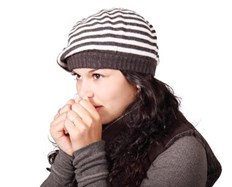Posted 15 December 2017
 Raynaud’s phenomenon is a highly inconvenient, annoying and
somewhat incapacitating condition for the estimated ten million UK people who
suffer with it. Reducing the blood supply to any of the extremities, it can
cause numbness, pain and difficulty in utilising the part of the body it
affects. (1)
Raynaud’s phenomenon is a highly inconvenient, annoying and
somewhat incapacitating condition for the estimated ten million UK people who
suffer with it. Reducing the blood supply to any of the extremities, it can
cause numbness, pain and difficulty in utilising the part of the body it
affects. (1)
What is Raynaud’s
phenomenon and what causes it?
Raynaud’s phenomenon, often shortened to Raynaud’s, is a
condition characterised by restricted blood supply to any of the extremities of
the body – usually this is the fingers or toes, but it can also affect the
ears, nose, lips and nipples. Depending on skin tone, the lack of blood flow to
the affected extremity can cause it to turn white or paler than usual, then
blue, then red as the blood supply is re-established. The area may become numb
or painful, and you may experience a ‘pins and needles’ sensation
(paraesthesia). These symptoms may be short-lived or persist for hours at a
time. They can make simple activities which are usually taken for granted much
more challenging, such as typing, buttoning up clothes and even speaking if the
lips are affected. Symptoms generally start in people in their twenties to
forties, but people of all ages can develop the condition. (1, 2)
The cause is the blood vessels in these areas of the body
being hypersensitive to temperature changes, or changes in blood flow as a
result of stress or anxiety. This in turn leads to spasm in the vessels,
restricting blood supply. (1, 2)
Raynaud’s is split into two forms:
Primary
Raynaud’s develops of its own accord and affected people can usually manage
the condition without input from their GP.
Secondary
Raynaud’s occurs as a result of another pre-existing condition – usually an
autoimmune condition such as rheumatoid arthritis. This type of Raynaud’s is
more severe than the primary type and will require medical input in the form of
monitoring for sores and, in the worst case scenario, gangrene. (1, 2)
Treatment and
management of Raynaud’s
The first-line approach to managing Raynaud’s is not medical
treatment, but self-care:
Make sure you wrap up warm in cold weather,
paying particular attention to the hands and feet (warm gloves and socks)
Encourage blood flow to the extremities through
exercise – 30 minutes at moderate intensity five times a week is recommended
Stopping smoking will also help to improve
circulation
Reduce stress where possible by eating well,
setting time aside to do something you enjoy and relaxation techniques
Don’t try to warm your hands and feet very
quickly by putting them next to or on a radiator or other hot object, as this
may cause chilblains (sore, itchy red lumps) to appear – this will only add to
your discomfort! (1, 3, 4)
If self-care is not sufficient to control the symptoms, you
may be prescribed a medicine called nifedipine,
the only licensed treatment in this country for Raynaud’s. This medicine
works by dilating the blood vessels, thereby improving circulation to the
body’s extremities. It is usually taken once daily, but you may be able to take
it only when you will most need it, for example in the winter months. If
nifedipine turns out to be unsuitable or does not work, there are a number of
unlicensed medicines available at the discretion of your doctor. (3)
In extreme cases, surgery known as sympathectomy may be
considered. The nerves responsible for the blood vessel spasms associated with
Raynaud’s are cut, stopping them from functioning. (3)
When to see your GP
If you have a long term condition such as an autoimmune
disease or diabetes and you begin to experience the symptoms described above,
see your GP as you may have secondary Raynaud’s which will need to be
monitored. Equally, make an appointment if your symptoms are interfering with
your everyday life and you cannot manage them on your own, or treatment has
failed to improve your symptoms.
For further information, click here.
References
NHS Choices. Overview [cited 6 December 2017].
Available from: https://www.nhs.uk/conditions/raynauds/
Scleroderma & Raynaud’s UK. What is
Raynaud’s? [cited 6 December 2017]. Available from: https://www.sruk.co.uk/raynauds/what-raynauds/
NHS Choices. Treatment [cited 6 December
2017]. Available from: https://www.nhs.uk/conditions/raynauds/treatment/
Scleroderma & Raynaud’s UK. Chilblains [cited
7 December 2017]. Available from: https://www.sruk.co.uk/raynauds/chilblains/
Author: Gabby Gallagher MPharm
Medically reviewed by: Superintendent pharmacist Margaret Hudson BSc(Hons)MRPharmS 15/12/17
Posted in Men's Health, Womens health